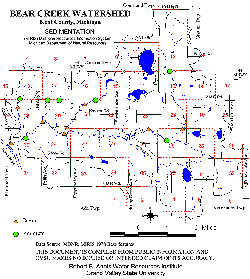Bear Creek Stewardship Plan - Existing and Potential Problems

A number of serious current or potential problems related to the quality of water in the Bear Creek Watershed have been identified. Although a variety of factors can be discerned as contributing to these problems, it is useful to consider most of them in relation to two overarching concerns - sedimentation and bacterial contamination - as well as a variety of secondary, but clearly interrelated factors.
Sedimentation
Excessive levels of sediment are found throughout the watercourses of the Bear Creek Watershed. The presence of sediment has been documented by a thorough field inspection of the main stream channel and a significant proportion of the tributaries during 1992-1993 by the staff of the Watershed Project, as well as by technical support staff from the GVSU Annis Water Resources Institute, the DNR District Water Quality Analyst and Wildlife Biologist, the Kent County SCS District Conservationist, WMEAC staff, Howard Christiansen Nature Center staff and many others. There is unanimous agreement that much of Bear Creek's original cobble and gravel bottom is now inundated by many layers of sediment, at times nearly a foot deep. Sediment is also present in the lakes of the watershed.
Figure 11 shows areas where visual inspection has documented stream sedimentation problems. As this map illustrates, areas do exist where the original bottom is in evidence. Even in these gravel or cobbled areas, however, the habitat of macro-invertebrates and trout is still threatened by the presence of sediment which has collected in the spaces between the small and large stones, affecting habitat quality. There are very few places within the waterway where sediment has not had some negative effect.
Figure 11.
Quantifying the exact levels of problematic nitrates and phosphates in this sediment resulting from fertilizers and human and animal wastes in the waters or the exact quantity of harmful chemicals from pesticide and herbicide use is a more difficult task. There is little question, however, that these are present and have a deleterious effect on water quality and the aquatic life it supports. The Project staff and technical consultants have documented numerous sites where livestock have access to the stream; furthermore, many sites are known where adjacent residential, agricultural or commercial stormwater runoff is believed to carry pesticides, herbicides and fertilizers which have been applied without full consideration of the nearby waterway. In some instances manicured residential lawns and public lands are planted and maintained down into the stream and lakes themselves, including use of fertilizers and other chemicals - practices which potentially contribute to the problems described.
In other locations, agricultural crops abut the waterway with little or no buffer zone to remove the chemical agents applied for crop management. Algae and other aquatic plant growth is also found in locations and amounts which reflect the effect of excessive phosphorous stimulation which has been documented by GVSU AWRI aquatic studies (David, 1993, draft). This evidence promotes the generation of a hypothesis that damaging levels of nitrates, phosphates and other nutrients may be present in the watershed.
